The Temporal and Spatial Evolution Characteristics and Driving Factors of Ecosystem Service Bundles in Anhui Province, China
Abstract
1. Introduction
2. Materials and Methods
2.1. Study Area
2.2. Data Source
2.3. Ecosystem Service Assessment
2.3.1. Carbon Sequestration (CS)
2.3.2. Habitat Quality (HQ)
2.3.3. Soil Conservation (SC)
2.3.4. Water Yield (WY)
2.3.5. Food Production (FP)
2.3.6. Landscape Aesthetics (LA)
2.4. Ecosystem Service Bundle Identification
2.5. Driving Factor Analysis
3. Results
3.1. Spatial and Temporal Distribution of Ecosystem Services
3.2. Ecosystem Service Bundles and Their Dynamic Evolution
3.3. Driving Factors of Ecosystem Service Bundle Changes
4. Discussion
4.1. Spatial and Temporal Distribution Patterns of Ecosystem Service Bundles
4.2. Ecosystem Service Bundles and Their Driving Factors
4.3. Limitations and Prospects
- (1)
- The township scale was consistent with the basic unit of ecosystem management policy implementation, which was conducive to the transformation of the research results into something more practical. However, the identification of ecosystem service bundles was affected by the evaluation methods and scales of ecosystem service capacity [31], which resulted in uncertainty in the analysis results. A comprehensive comparison of the evaluation results achieved for multiple scales and coupling them with real-life situations can ensure the scientificity and rigor of this study’s results.
- (2)
- Urban ecosystem services and their integrated management are greatly influenced by economic development and social demands [56]. This study only evaluated these factors from the supply perspective, then identified the service bundles. In the future, ecosystem services and service bundles can be comprehensively analyzed from both supply and demand perspectives.
- (3)
- As ecosystem services are provided through multiple correlated ecological processes, complex relationships usually exist among them, i.e., trade-off and synergy [57,58]. Thus, a managment decision aiming to improve an ecosystem service usually results in an improvement or degradation of another. More attention must be paid to the trade-offs and synergies in ecosystem service bundles to provide more comprehensive theoretical support for ecosystem service management.
5. Conclusions
- (1)
- On the spatial scale, various ecosystem services exhibited significant spatial differentiation characteristics. HQ, CS, and SC services tended to be lower in the north and higher in the south, with high-value areas primarily located in the western Dabie Mountains and Southern Anhui Mountains. Conversely, FP services showed an opposite trend, while WY services displayed a gradually increasing pattern from north to south. Cultural services were spatially distributed, with high-value areas mainly located in the western Dabie Mountains and Yangtze River Basin. Temporally, from 2000 to 2020, the annual average values of WY, SC, and FP services generally presented an upward trend, with significant increases, whereas HQ, CS services, and cultural services exhibited a downward trend, albeit with minor fluctuations.
- (2)
- Anhui Province can be categorized into four types of service bundles: the GPB, MECB, ULB, and CPB. Each type of service bundle demonstrates distinct spatial differentiation, with similar bundles exhibiting a pronounced clustering effect in space. From 2000 to 2020, there were notable changes in quantity and spatial distribution. The GPB was the predominant local service bundle, though its dominance diminished while the proportion of the ULBs gradually increased. The numbers of MECBs and CPBs remained relatively stable.
- (3)
- In the spatio-temporal evolution of ecosystem service bundles, natural factors exerted a more decisive influence than socio-economic factors. Annual precipitation, forest land proportion, and slope were the primary natural factors affecting the spatio-temporal evolution of ecosystem service bundles, while the proportion of construction land was the dominant socio-economic factor.
Author Contributions
Funding
Data Availability Statement
Conflicts of Interest
References
- Jiang, W.; Wu, T.; Fu, B. The Value of Ecosystem Services in China: A Systematic Review for Twenty Years. Ecosyst. Serv. 2021, 52, 101365. [Google Scholar] [CrossRef]
- Daily, G.C. Nature’s Services: Societal Dependence on Natural Ecosystems (1997). In Nature’s Services: Societal Dependence on Natural Ecosystems (1997); Yale University Press: New Haven, CT, USA, 2013. [Google Scholar]
- Dai, E.; Wang, X.; Zhu, J.; Zhao, D. Methods, tools and research framework of ecosystem service trade-offs. Geogr. Res. 2016, 35, 1005–1016. [Google Scholar]
- Roque Guerrero, J.V.; Teixeira Gomes, A.A.; de Lollo, J.A.; Moschini, L.E. Mapping Potential Zones for Ecotourism Ecosystem Services as a Tool to Promote Landscape Resilience and Development in a Brazilian Municipality. Sustainability 2020, 12, 10345. [Google Scholar] [CrossRef]
- Egoh, B.; Reyers, B.; Rouget, M.; Richardson, D.M.; Le Maitre, D.C.; van Jaarsveld, A.S. Mapping Ecosystem Services for Planning and Management. Agric. Ecosyst. Environ. 2008, 127, 135–140. [Google Scholar] [CrossRef]
- de Groot, R.S.; Alkemade, R.; Braat, L.; Hein, L.; Willemen, L. Challenges in Integrating the Concept of Ecosystem Services and Values in Landscape Planning, Management and Decision Making. Ecol. Complex. 2010, 7, 260–272. [Google Scholar] [CrossRef]
- Kareiva, P.; Watts, S.; McDonald, R.; Boucher, T. Domesticated Nature: Shaping Landscapes and Ecosystems for Human Welfare. Science 2007, 316, 1866–1869. [Google Scholar] [CrossRef]
- Renard, D.; Rhemtulla, J.M.; Bennett, E.M. Historical Dynamics in Ecosystem Service Bundles. Proc. Natl. Acad. Sci. USA 2015, 112, 13411–13416. [Google Scholar] [CrossRef] [PubMed]
- Li, H.; Peng, J.; Hu, Y.; Wu, W. Ecological function zoning in Inner Mongolia Autonomous Region based on ecosystem service bundles. Chin. J. Appl. Ecol. 2017, 28, 2657–2666. [Google Scholar] [CrossRef]
- Liu, S.; Zhang, H.; Pei, X.; Wang, Y. Ecological Function Zoning Based on Spatiotemporal Change of Ecosystem Service Bundles: A Case Study of Wuhu City in Anhui Province. Chin. Landsc. Archit. 2023, 39, 121–125. [Google Scholar] [CrossRef]
- Queiroz, C.; Meacham, M.; Richter, K.; Norström, A.V.; Andersson, E.; Norberg, J.; Peterson, G. Mapping Bundles of Ecosystem Services Reveals Distinct Types of Multifunctionality within a Swedish Landscape. AMBIO 2015, 44, 89–101. [Google Scholar] [CrossRef]
- Shen, J.; Liang, Z.; Liu, L.; Li, D.; Zhang, Y.; Li, S. Trade-offs and synergies of ecosystem service bundles in Xiong’an New Area. Geogr. Res. 2020, 39, 79–91. [Google Scholar]
- Bai, Y.; Ochuodho, T.O.; Yang, J.; Agyeman, D.A. Bundles and Hotspots of Multiple Ecosystem Services for Optimized Land Management in Kentucky, United States. Land 2021, 10, 69. [Google Scholar] [CrossRef]
- Feurer, M.; Heinimann, A.; Schneider, F.; Jurt, C.; Myint, W.; Zaehringer, J.G. Local Perspectives on Ecosystem Service Trade-Offs in a Forest Frontier Landscape in Myanmar. Land 2019, 8, 45. [Google Scholar] [CrossRef]
- Feng, Z.; Peng, J.; Wu, J. Ecosystem service bundles based approach to exploring the trajectories of ecosystem service spatiotemporal change: A case study of Shenzhen City. Acta Ecol. Sin. 2020, 40, 2545–2554. [Google Scholar]
- Liu, Y.; Lü, Y.; Fu, B.; Harris, P.; Wu, L. Quantifying the Spatio-Temporal Drivers of Planned Vegetation Restoration on Ecosystem Services at a Regional Scale. Sci. Total Environ. 2019, 650, 1029–1040. [Google Scholar] [CrossRef] [PubMed]
- Sasaki, K.; Hotes, S.; Ichinose, T.; Doko, T.; Wolters, V. Hotspots of Agricultural Ecosystem Services and Farmland Biodiversity Overlap with Areas at Risk of Land Abandonment in Japan. Land 2021, 10, 1031. [Google Scholar] [CrossRef]
- Lyu, R.; Clarke, K.C.; Zhang, J.; Feng, J.; Jia, X.; Li, J. Spatial Correlations among Ecosystem Services and Their Socio-Ecological Driving Factors: A Case Study in the City Belt along the Yellow River in Ningxia, China. Appl. Geogr. 2019, 108, 64–73. [Google Scholar] [CrossRef]
- Yang, G.; Ge, Y.; Xue, H.; Yang, W.; Shi, Y.; Peng, C.; Du, Y.; Fan, X.; Ren, Y.; Chang, J. Using Ecosystem Service Bundles to Detect Trade-Offs and Synergies across Urban–Rural Complexes. Landsc. Urban Plan. 2015, 136, 110–121. [Google Scholar] [CrossRef]
- Maes, J.; Paracchini, M.L.; Zulian, G.; Dunbar, M.B.; Alkemade, R. Synergies and Trade-Offs between Ecosystem Service Supply, Biodiversity, and Habitat Conservation Status in Europe. Biol. Conserv. 2012, 155, 1–12. [Google Scholar] [CrossRef]
- Jaung, W.; Bull, G.Q.; Putzel, L.; Kozak, R.; Elliott, C. Bundling Forest Ecosystem Services for FSC Certification: An Analysis of Stakeholder Adaptability. Int. Forest. Rev. 2016, 18, 452–465. [Google Scholar] [CrossRef]
- Gan, S.; Xiao, Y.; Qin, K.; Liu, J.; Xu, J.; Wang, Y.; Niu, Y.; Huang, M.; Xie, G. Analyzing the Interrelationships among Various Ecosystem Services from the Perspective of Ecosystem Service Bundles in Shenyang, China. Land 2022, 11, 515. [Google Scholar] [CrossRef]
- Chen, T.; Feng, Z.; Zhao, H.; Wu, K. Identification of Ecosystem Service Bundles and Driving Factors in Beijing and Its Surrounding Areas. Sci. Total Environ. 2020, 711, 134687. [Google Scholar] [CrossRef] [PubMed]
- Xu, J.; Wang, S.; Xiao, Y.; Xie, G.; Wang, Y.; Zhang, C.; Li, P.; Lei, G. Mapping the Spatiotemporal Heterogeneity of Ecosystem Service Relationships and Bundles in Ningxia, China. J. Clean. Prod. 2021, 294, 126216. [Google Scholar] [CrossRef]
- Liu, S.; Chen, N.; Dong, Y. A Study on the Zoning of Ecological Functions and Control Strategies Based on the Perspective of Ecosystem Service Bundles: Case Study in Jiaxing. Landsc. Archit. 2022, 39, 21–29. [Google Scholar]
- Dittrich, A.; Seppelt, R.; Václavík, T.; Cord, A.F. Integrating Ecosystem Service Bundles and Socio-Environmental Conditions–A National Scale Analysis from Germany. Ecosyst. Serv. 2017, 28, 273–282. [Google Scholar] [CrossRef]
- Raudsepp-Hearne, C.; Peterson, G.D.; Bennett, E.M. Ecosystem Service Bundles for Analyzing Tradeoffs in Diverse Landscapes. Proc. Natl. Acad. Sci. USA 2010, 107, 5242–5247. [Google Scholar] [CrossRef] [PubMed]
- Li, T.; Lü, Y.; Fu, B.; Hu, W.; Comber, A.J. Bundling Ecosystem Services for Detecting Their Interactions Driven by Large-Scale Vegetation Restoration: Enhanced Services While Depressed Synergies. Ecol. Indic. 2019, 99, 332–342. [Google Scholar] [CrossRef]
- Liu, Y.; Li, T.; Zhao, W.; Wang, S.; Fu, B. Landscape Functional Zoning at a County Level Based on Ecosystem Services Bundle: Methods Comparison and Management Indication. J. Environ. Manag. 2019, 249, 109315. [Google Scholar] [CrossRef]
- Gou, M.; Li, L.; Ouyang, S.; Wang, N.; La, L.; Liu, C.; Xiao, W. Identifying and Analyzing Ecosystem Service Bundles and Their Socioecological Drivers in the Three Gorges Reservoir Area. J. Clean. Prod. 2021, 307, 127208. [Google Scholar] [CrossRef]
- Madrigal-Martínez, S.; Miralles I García, J.L. Assessment Method and Scale of Observation Influence Ecosystem Service Bundles. Land 2020, 9, 392. [Google Scholar] [CrossRef]
- Liu, J.; Li, J.; Qin, K.; Zhou, Z.; Yang, X.; Li, T. Changes in Land-Uses and Ecosystem Services under Multi-Scenarios Simulation. Sci. Total Environ. 2017, 586, 522–526. [Google Scholar] [CrossRef]
- Hamann, M.; Biggs, R.; Reyers, B. Mapping Social–Ecological Systems: Identifying ‘Green-Loop’ and ‘Red-Loop’ Dynamics Based on Characteristic Bundles of Ecosystem Service Use. Glob. Environ. Change 2015, 34, 218–226. [Google Scholar] [CrossRef]
- Baró, F.; Gómez-Baggethun, E.; Haase, D. Ecosystem Service Bundles along the Urban-Rural Gradient: Insights for Landscape Planning and Management. Ecosyst. Serv. 2017, 24, 147–159. [Google Scholar] [CrossRef]
- Yang, W.; Wang, C.; Sun, X.; Yang, P.; Wang, Y. Impacts of landscape pattern on ecosystem and the spatial optimization of agricultural production region-A case of Beijing. Chin. J. Agric. Resour. Reg. Plan. 2024, 45, 116–128. [Google Scholar]
- Wang, J.; Xu, C. Geodetector: Principle and prospective. Acta Geogr. Sin. 2017, 72, 116–134. [Google Scholar]
- Su, Y.; Li, T.; Cheng, S.; Wang, X. Spatial Distribution Exploration and Driving Factor Identification for Soil Salinisation Based on Geodetector Models in Coastal Area. Ecol. Eng. 2020, 156, 105961. [Google Scholar] [CrossRef]
- Cao, Y.; Sun, Y.; Chen, Z.; Yan, H.; Qian, S. Dynamic Changes of Vegetation Ecological Quality in the Yellow River Basin and Its Response to Extreme Climate during 2000–2020. Acta Ecol. Sin. 2022, 42, 4524–4535. [Google Scholar] [CrossRef]
- Liu, Y.; Zhang, J.; Zhou, D.; Ma, J.; Dang, R.; Ma, J.; Zhu, X. Temporal and Spatial Variation of Carbon Storage in the Shule River Basin Based on InVEST Model. Acta Ecol. Sin. 2021, 41, 4052–4065. [Google Scholar] [CrossRef]
- Sun, F.; Fang, F.; Hong, W.; Luo, H.; Yu, J.; Fang, L.; Miao, Y. Evolution Analysis and Prediction of Carbon Storage in Anhui Province Based on PLUS and InVEST Model. J. Soil Water Conserv. 2023, 37, 151–158. [Google Scholar] [CrossRef]
- Sharp, R.; Tallis, H.T.; Ricketts, T. InVEST Version 3.2.0 User’s Guide; The Natural Capital Project: Stanford, CA, USA, 2015. [Google Scholar]
- Wen, X.; Wang, J.; Han, X.; Ma, L. Where Are the Trade-Offs in Multiple Ecosystem Services in the Process of Ecological Restoration? A Case Study on the Vegetation Restoration Area in the Loess Plateau, Northern Shaanxi. Land 2024, 13, 70. [Google Scholar] [CrossRef]
- Wall, D.H.; Six, J. Give Soils Their Due. Science 2015, 347, 695. [Google Scholar] [CrossRef] [PubMed]
- Zhao, G.; Mu, X.; Wen, Z.; Wang, F.; Gao, P. Soil erosion, conservation, and eco-environment changes in the loess plateau of China. Land Degrad. Dev. 2013, 24, 499–510. [Google Scholar] [CrossRef]
- Yue, W.; Hou, L.; Xia, H.; Wei, J.; Lu, Y. Territorially Ecological Restoration Zoning and Optimization Strategy in Guyuan City of Ningxia, China: Based on the Balance of Ecosystem Service Supply and Demand. Ying Yong Sheng Tai Xue Bao = J. Appl. Ecol. 2022, 33, 149–158. [Google Scholar]
- Tao, P.; Wu, S.-h.; Dai, E.-f.; Liu, Y.-j. Spatiotemporal Variation of Water Source Supply Service in Three Rivers Source Area of China Based on InVEST Model. Chin. J. Appl. Ecol. 2013, 24, 183. [Google Scholar]
- Peng, L.; Deng, W.; Huang, P.; Liu, Y. Evaluation of multiple ecosystem services landscape index and identification ofecosystem services bundles in Sichuan Basin. Acta Ecol. Sin. 2021, 41, 9328–9340. [Google Scholar]
- Liu, D.; Chen, H.; Li, T.; Zhang, H.; Geng, Y. Spatiotemporal differentiation of village ecosystem service bundles in the loess hilly and gully region and terrain gradient analysis. Prog. Geogr. 2022, 41, 670–681. [Google Scholar] [CrossRef]
- Qiao, X.; Yang, Z.; Yang, Y. Trade-off and Synergy of Ecosystem Services and Their Scale Effects in the Huaihe River Basin from 1995 to 2020. Areal Res. Dev. 2023, 42, 150–154+166. [Google Scholar]
- Kong, L.; Zheng, H.; Xiao, Y.; Ouyang, Z.; Li, C.; Zhang, J.; Huang, B. Mapping Ecosystem Service Bundles to Detect Distinct Types of Multifunctionality within the Diverse Landscape of the Yangtze River Basin, China. Sustainability 2018, 10, 857. [Google Scholar] [CrossRef]
- Wang, B.; Wang, L.; Chen, J.; Qi, Q.; He, S.; Yang, X.; Li, Z.; Li, H. Identification of ecological functional zoning and its influencing factors in the Sihu Lake Basin, China. Chin. J. Appl. Ecol. 2023, 34, 2757–2766. [Google Scholar] [CrossRef]
- Lamarque, P.; Lavorel, S.; Mouchet, M.; Quetier, F. Plant Trait-Based Models Identify Direct and Indirect Effects of Climate Change on Bundles of Grassland Ecosystem Services. Proc. Natl. Acad. Sci. USA 2014, 111, 13751–13756. [Google Scholar] [CrossRef]
- Feng, Q.; Zhao, W.; Fu, B.; Ding, J.; Wang, S. Ecosystemservice Trade-Offs and Their Influencing Factors: A Case Study in the Loess Plateau of China. Sci. Total Environ. 2017, 607, 1250–1263. [Google Scholar] [CrossRef] [PubMed]
- Pan, Y.; Zheng, H.; Yi, Q.; Li, R. The change and driving factors of ecosystem service bundles: A case study of Daqing River Basin. Acta Ecol. Sin. 2021, 41, 5204–5213. [Google Scholar]
- Yan, X.; Li, X.; Liu, C.; Li, J.; Zhong, J. Spatial evolution trajectory of ecosystem service bundles and its social-ecological driven by geographical exploration: A case study of Dalian. Acta Ecol. Sin. 2022, 42, 5734–5747. [Google Scholar]
- Meng, X.; Wu, Y. Supply-demand bundles and ecological function management of urban ecosystem services: Taking central urban area of Oigihar as an example. Chin. J. Appl. Ecol. 2023, 34, 3393–3403. [Google Scholar] [CrossRef] [PubMed]
- Cord, A.F.; Bartkowski, B.; Beckmann, M.; Dittrich, A.; Hermans-Neumann, K.; Kaim, A.; Lienhoop, N.; Locher-Krause, K.; Priess, J.; Schroeter-Schlaack, C.; et al. Towards Systematic Analyses of Ecosystem Service Trade-Offs and Synergies: Main Concepts, Methods and the Road Ahead. Ecosyst. Serv. 2017, 28, 264–272. [Google Scholar] [CrossRef]
- Zheng, H.; Wang, L.; Wu, T. Coordinating Ecosystem Service Trade-Offs to Achieve Win-Win Outcomes: A Review of the Approaches. J. Environ. Sci. 2019, 82, 103–112. [Google Scholar] [CrossRef]
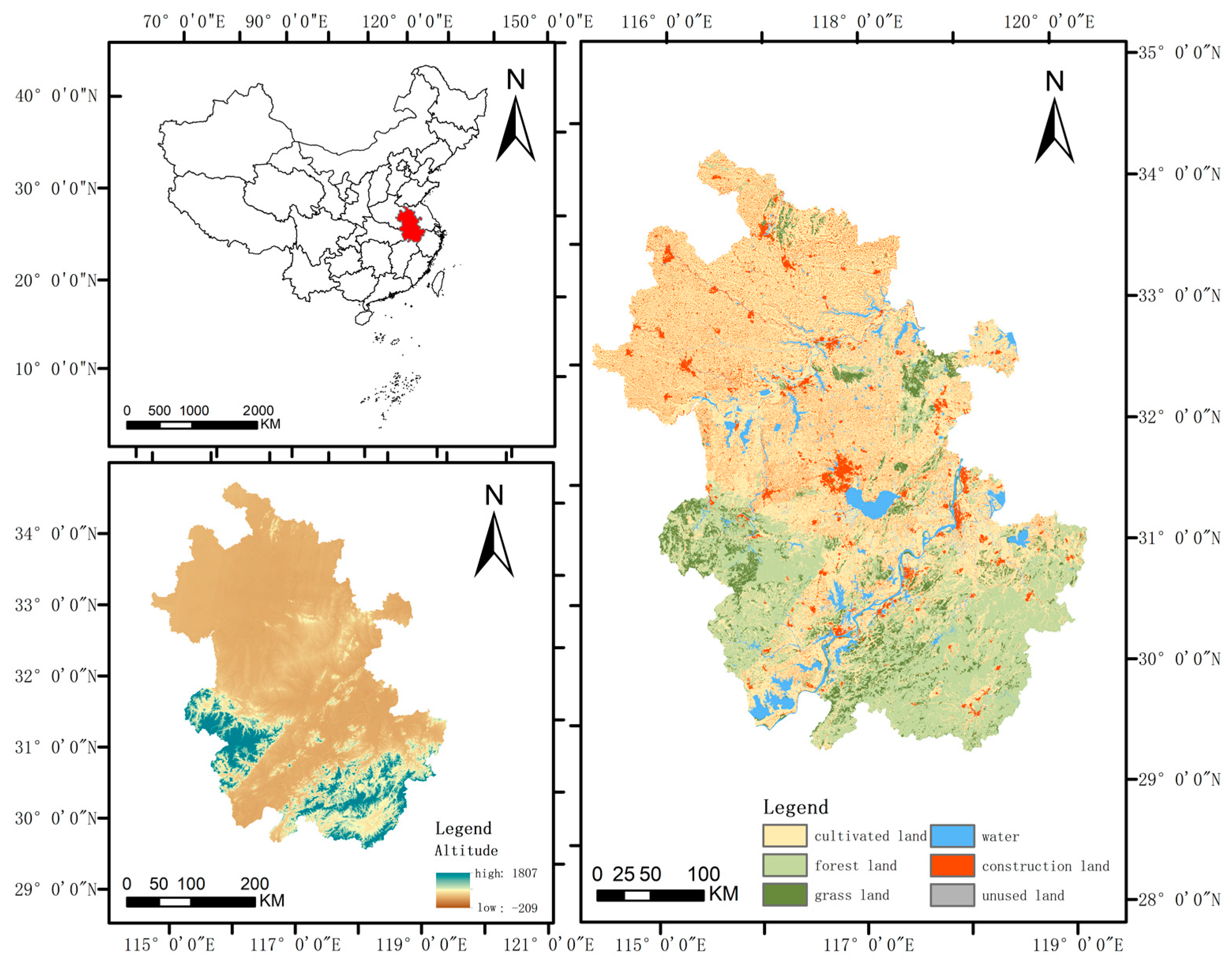
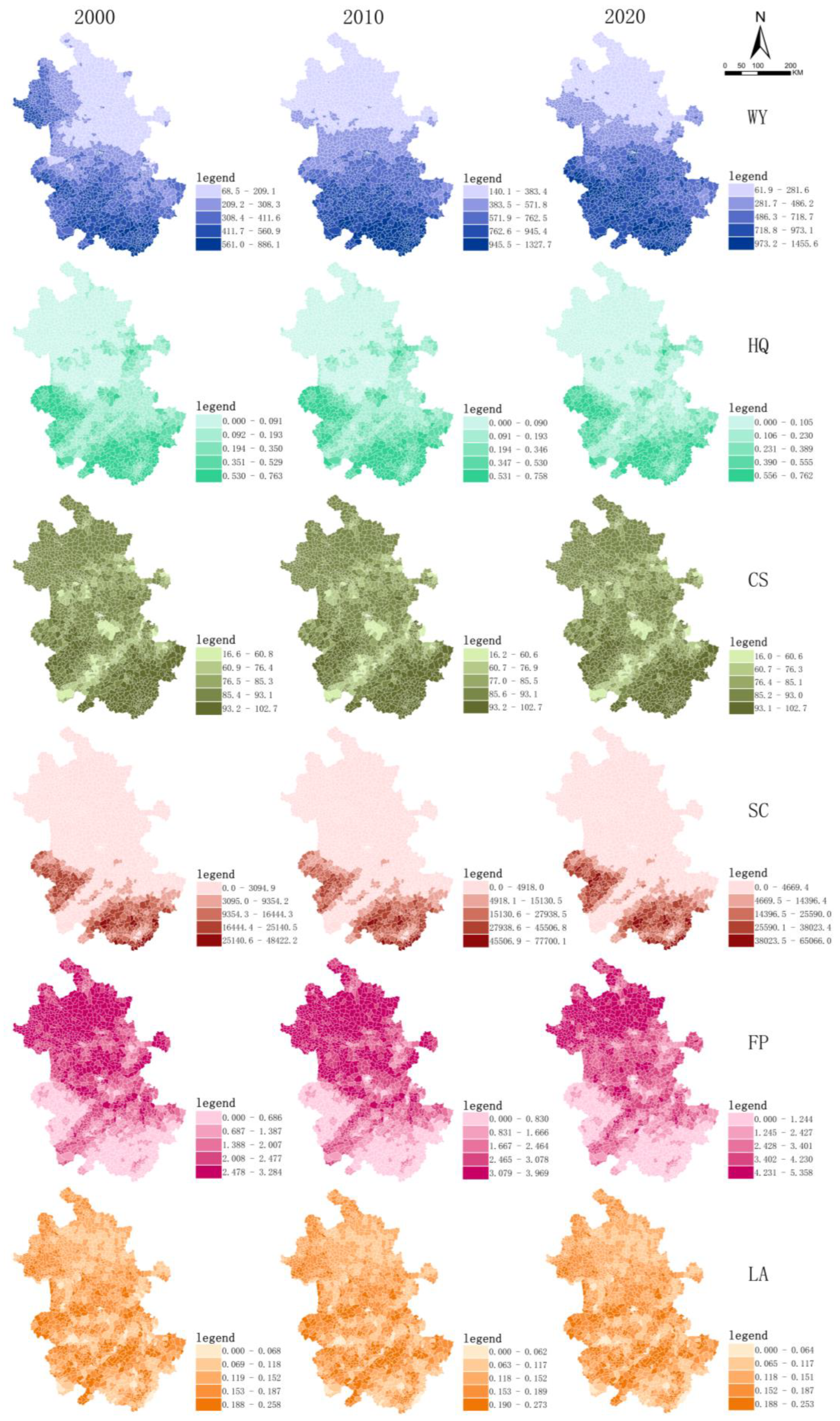
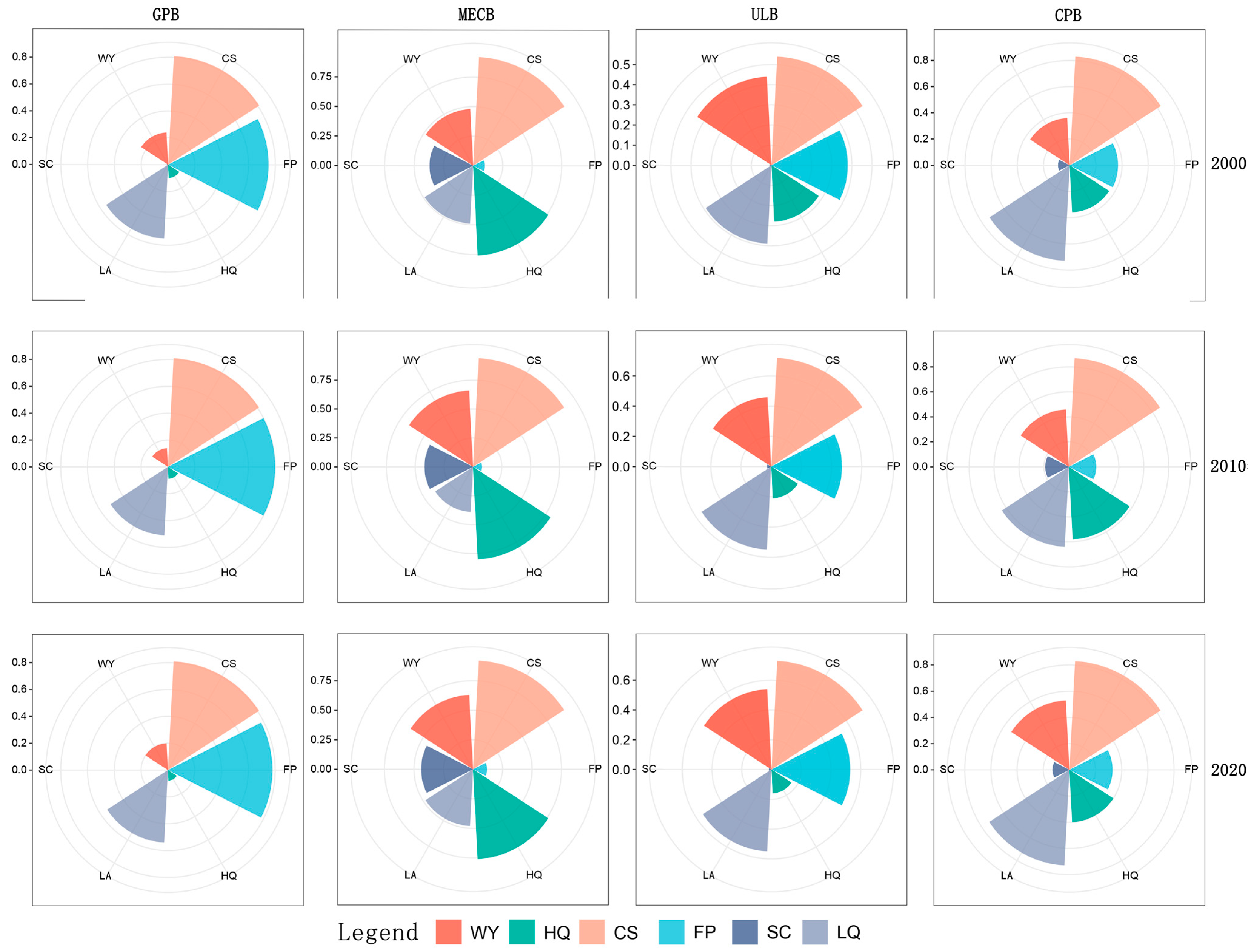
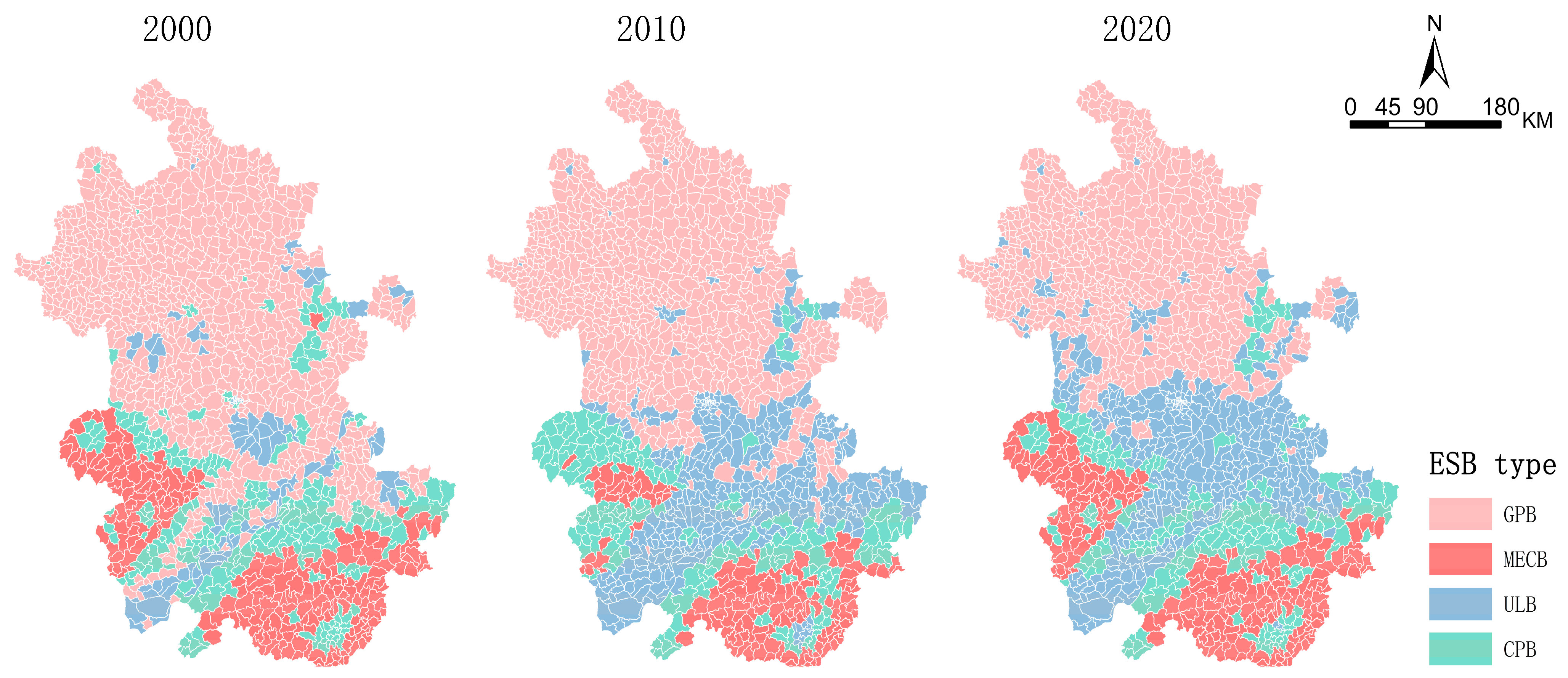
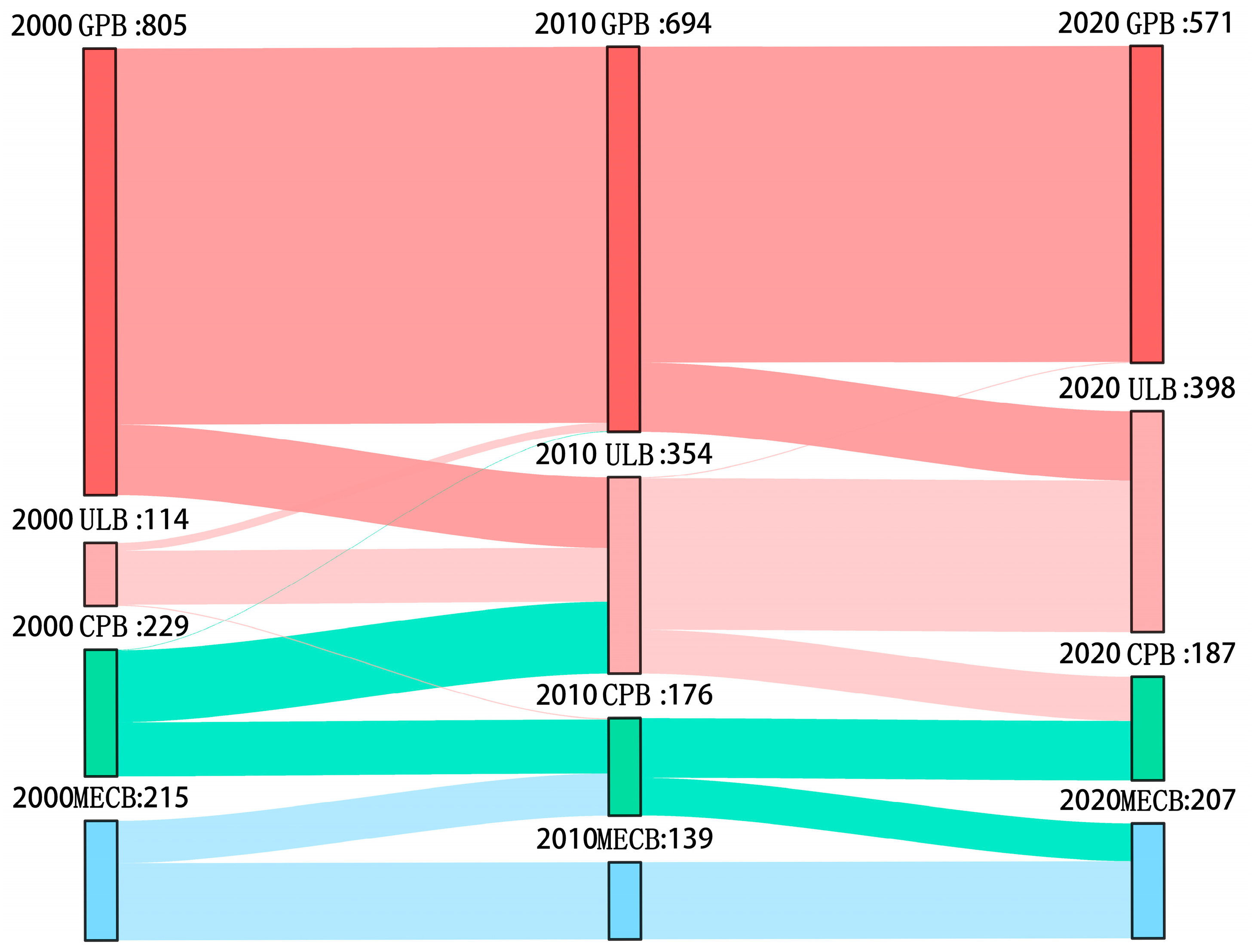
| Element Layer | Indicator Layer | Weight |
|---|---|---|
| LA | SHDI | 0.5 |
| CONTAG | 0.5 |
| Element Layer | Indicator Layer |
|---|---|
| Socio-Economic Factors | Proportion of Construction Land |
| Gross Domestic Product | |
| Population Density | |
| Natural Factors | Normalized Difference Vegetation Index |
| Slope | |
| Elevation | |
| Forest Cover Ratio | |
| Annual Average Precipitation | |
| Annual Average Temperature |
| Year | WY (mm) | HQ | CS (t/hm2) | SC (t/hm2) | FP (t/hm2) | LA |
|---|---|---|---|---|---|---|
| 2000 | 306.361 | 0.232 | 86.692 | 4326.390 | 1.764 | 0.144 |
| 2010 | 504.853 | 0.229 | 86.535 | 6804.217 | 2.199 | 0.144 |
| 2020 | 609.628 | 0.224 | 86.201 | 7017.988 | 2.869 | 0.143 |
| Change from 2000 to 2010 | 198.492 | −0.003 | −0.157 | 2477.827 | 0.435 | 0 |
| Change from 2010 to 2020 | 104.775 | −0.005 | −0.334 | 213.771 | 0.67 | −0.001 |
| Change from 2000 to 2020 | 303.267 | −0.008 | −0.491 | 2691.598 | 1.105 | −0.001 |
| Element Layer | Indicator Layer | 2000 | 2010 | 2020 | Mean |
|---|---|---|---|---|---|
| Socio-Economic Factors | Proportion of Construction Land | 0.381 | 0.466 | 0.280 | 0.376 |
| Gross Domestic Product | 0.075 | 0.079 | 0.045 | 0.066 | |
| Population Density | 0.148 | 0.141 | 0.090 | 0.126 | |
| Natural Factors | Normalized Difference Vegetation Index | 0.108 | 0.099 | 0.142 | 0.116 |
| Slope | 0.456 | 0.482 | 0.323 | 0.420 | |
| Elevation | 0.329 | 0.339 | 0.211 | 0.293 | |
| Forest Cover Ratio | 0.441 | 0.499 | 0.362 | 0.434 | |
| Annual Average Precipitation | 0.329 | 0.604 | 0.623 | 0.518 | |
| Annual Average Temperature | 0.133 | 0.277 | 0.459 | 0.289 |
Disclaimer/Publisher’s Note: The statements, opinions and data contained in all publications are solely those of the individual author(s) and contributor(s) and not of MDPI and/or the editor(s). MDPI and/or the editor(s) disclaim responsibility for any injury to people or property resulting from any ideas, methods, instructions or products referred to in the content. |
© 2024 by the authors. Licensee MDPI, Basel, Switzerland. This article is an open access article distributed under the terms and conditions of the Creative Commons Attribution (CC BY) license (https://creativecommons.org/licenses/by/4.0/).
Share and Cite
Mei, Z.; Li, C.; Zhao, J.; Li, Z.; Chen, K.; Huang, X.; Zhao, Z. The Temporal and Spatial Evolution Characteristics and Driving Factors of Ecosystem Service Bundles in Anhui Province, China. Land 2024, 13, 736. https://doi.org/10.3390/land13060736
Mei Z, Li C, Zhao J, Li Z, Chen K, Huang X, Zhao Z. The Temporal and Spatial Evolution Characteristics and Driving Factors of Ecosystem Service Bundles in Anhui Province, China. Land. 2024; 13(6):736. https://doi.org/10.3390/land13060736
Chicago/Turabian StyleMei, Zhongjian, Cheng Li, Jie Zhao, Zixuan Li, Kaiyi Chen, Xin Huang, and Zhiyue Zhao. 2024. "The Temporal and Spatial Evolution Characteristics and Driving Factors of Ecosystem Service Bundles in Anhui Province, China" Land 13, no. 6: 736. https://doi.org/10.3390/land13060736
APA StyleMei, Z., Li, C., Zhao, J., Li, Z., Chen, K., Huang, X., & Zhao, Z. (2024). The Temporal and Spatial Evolution Characteristics and Driving Factors of Ecosystem Service Bundles in Anhui Province, China. Land, 13(6), 736. https://doi.org/10.3390/land13060736






